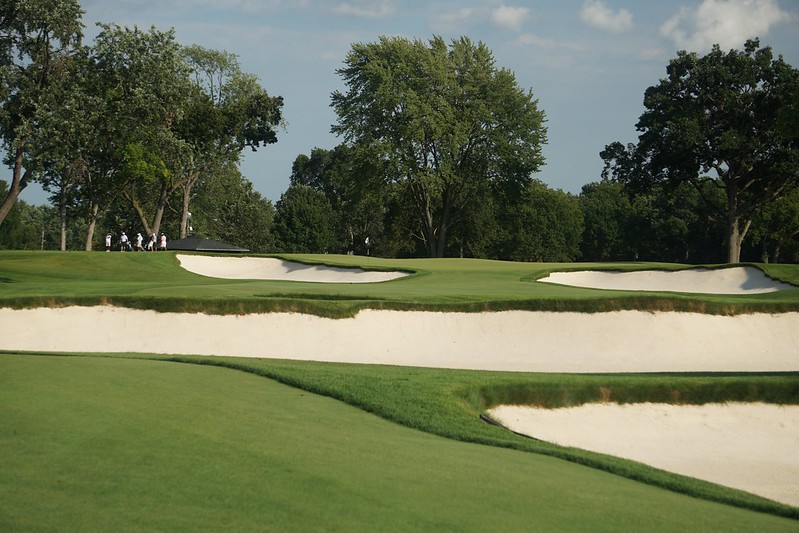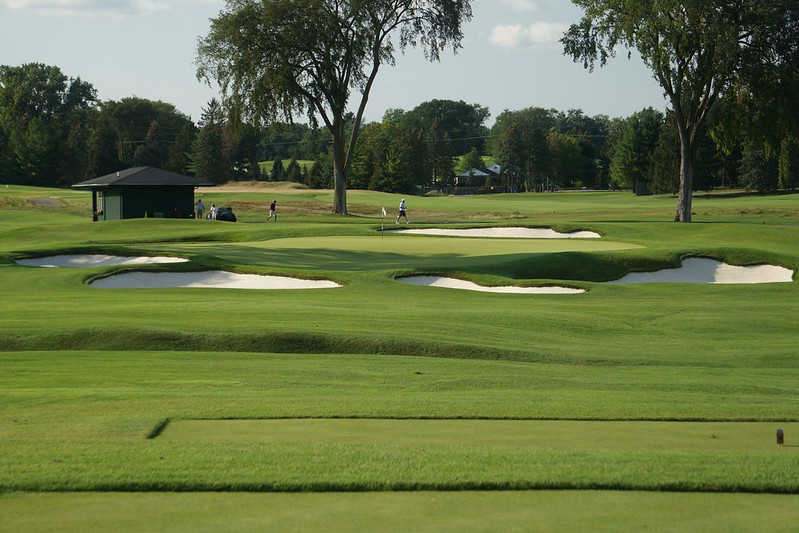What do you want most out of US Open venues? Length and brute challenge? Width and angles? What about a mixture of both, where tacticians can compete alongside the bombers? In August I visited the South Course at Oakland Hills, and I wouldnít be surprised if the only US Open venues that can genuinely exceed it after Gil Hanseís masterful restoration are Oakmont, Shinnecock, and Merion. Though I havenít seen Winged Foot in person, Oaklandís landóand the newfound ability to see itóhas to beat WF, and the greens are likely in close competition. The ingenuity of OHís greens surpass Pebble Beach, and although Pebble benefits from its coastline location, especially world class holes 6 and 8, Iíd rather watch pros face long putts on the magnificent set of greens at Oakland Hills. Itíll be interesting over time, as the course grows in and raters flock to Detroit, to see if the course can supplant Pinehurst #2 (or Seminole, depending on whom you ask) as Rossís best. It is likely that good, and could foreseeably settle comfortably in the 10-15 range of US golf course rankings.
Although the total number of bunkers decreased, the restoration led to a dramatic increase in the amount of sand coverage. These imposingly large expanses of bone colored sand flash from fairways and rough like high beam headlights shining head-on as you squint at your options from the tee. They heavily affect strategy on nearly every shot, not only by drawing your attention away from ideal lines, but optically confusing your sense of how much landing area you really have between their befuddling placements. The brilliant result is that the bunkering presents you with multiple opportunities to think carefully about optimal carry yardages and where to try to place your ball. When (it shouldnít be if) OHCC hosts a US Open, itíll be interesting to see just how frequently pros will be approaching greens from bunkers as opposed to only rough. This feature is particularly noticeable on holes 3, 5, 6, 10, and 12.
While the rough is still penal, and I found myself intimately acquainted with it, I have to imagine the membership and returning guests find the course more playable that its previous iteration, especially after a few loops when one has gained a better sense of how much club is necessary to carry said bunkers, with the added confidence that taking them on is oftentimes the rewarding play.
Playing Oakland Hills was also a humbling reminder that the scale of championship courses induces in me a kind of amnesia of its more finessed nuances. I marveled at 1 green, its bulges rising across the surface like bubbles in a rising dough, the slope running front to back on the right side banking like a skate ramp. But after trudging through enough rough in sweltering heat on a 36 hole day that began at Mike DeVriesís wondrous revitalization of Harry Coltís Bloomfield Hills, I realized afterwards how much more attention I still need to pay to green complexes. Immediately following my round there were a few holes Iíd almost completely forgotten, not because there are weak holes on the propertyóthere arenítóbut on account of being over stimulated for four straight hours.
I experienced something similar at Prairie Dunes, the only other course Iíve seen whose greens stunned me in the same way as Oakland Hills. Maybe itís on account of greens that are so good, so varied, that theyíre difficult to memorize in their myriad forms. Perhaps a course featuring holes or greens that are elusive in memory indicates how exceptional it is. You canít contain its subtleties because there are too many. In that case, elusiveness is a marker of design brilliance, prompting return visits to unravel its finer points. Already I canít wait to revisit Oakland Hills for those reasons.
Below are brief blurbs of holes that I managed to somewhat photograph. Yardages are from blue tees: 73.3/137/6833.
Hole 1 - Par 4, 428

A straightaway par 4 with a receptive opening to the green, especially on the left side that funnels towards the center. Iíve never been as impressed by an opening holeís green as this one, with a sunken center exerting its own gravitational force around beautiful ramped slopes falling into it.
Hole 3 - Par 3, 190

A large green with an elevated mound in the back left, but whatís visually disconcerting is your inability to truly see where the green begins and ends. A large bunker obscures the front edge, and the left bunker seemingly cuts itself into what looks like the middle of the green pad, making you think thereís far less room than whatís available. From the tee, the gap between the two greenside bunkers appears miniscule, as if you could stand with one foot in each bunkerís bordered fringe of rough. A wonderful example of the visual deception Ross and Hanse have in store for players going forward.
Hole 5 - Par 4, 430

Much of the hole appears to be swallowed by the first two bunkers flanking both sides of the fairway, as though they were sinkholes threatening to further widen. The flag is directly ahead in the distance, but add in that thereís a small creek blindly bisecting the fairway and suddenly the hole desperately calls for a good caddie or yardage book more than any other yet on the outward nine.
Hole 6 - Par 4, 344

A bracing amount of back to front slope on the green makes up for the shorter yardage, and again a significant right bunker occupies the ideal area from which to approach. Would like to see this hole set up as a drivable par 4 one day in a major.
Hole 7 - Par 4, 369

No longer should the 16th be referred to as the signature hole. The visual stack of 7 and 8 is second to none on the course. The sensible tee shot calls for no more than 220-250 yards. Staying short and as close to the creek on the right leaves for a straighter approach with a receptive opening to the green. The deeper you drive along the left side, the worse the angle, requiring a wedge over the hazard and a steep fronting bank of rough.
 7 green as seen from hole 2, with 11 fairway in background
7 green as seen from hole 2, with 11 fairway in backgroundHole 8 - Par 5, 460
A wonderful hole that, due to its tame length, likely gets its fair share of players going for it in two. But the rise to the green benched just below the top of the hill rejects any shot left short.
Hole 9 - Par 3, 219

As if its length, scale, and the imposing clubhouse looming directly behind wasnít formidable enough, I had the pleasure of experiencing this green with a back left pin.
Hole 10 - Par 4, 446

Possibly the best fairway on property. Muscular with its contoured humps and rolls. The ridgeline possessing both 10 green and 17 green further left affords a magnificent view. Note how 10ís left fairway bunker appears to be touching (!) the greenside right bunker of 17. Golf clap, Mr. Hanse.
Hole 11 - Par 4, 415

My favorite hole. Ross mustíve held some kind of superstition with the number 11, because the 11th hole lays claim to the most dramatic green complex not only at Oakland Hills South, but arguably Plainfield and Essex County as well. Though I havenít seen the other two in person yet, each green curves over the crest of a rounded hillside with a severe front slope. The green reminds me of an ocean waveís heavy barrel of water after it has just tumbled forward, its surface entirely smooth the moment before erupting into a thunderclap of whitewater. You donít want to be staring at it from belowówhether youíre a golfer or surfer! Fortunately I got up and down for a memorable par.
 The place from which pars become memorable
The place from which pars become memorableHole 12 - Par 5, 520

If this photo of the third shot can reiterate it at all, there are countless sight-lines on property where all you can see and think about is sand.
Hole 13 - Par 3, 158

A semblance of respite after 8-12. Or maybe it was the drink after walking off the green. Reminiscent of Aroniminkís par 3 5th, although I found the green at Aronimink more riveting.
Hole 14 - Par 4, 472
No photos of 14, which is a shame, because while itís the longest par 4 on the scorecard, the green is set below the approaching fairway and is a rare instance where the ball can trundle along the ground and onto the putting surface. The green was one of my favorites, sloping from front to back, with a centering bowl similar to 1 green.
Hole 15 - Par 4, 362

Another hole where, from the blue tees, a drive over 250 is imprudent unless youíre shaping it right to left along the dogleg, but the bunkering leaves the impression of a minefield on approach towards an elevated green site. The conservative tee ball up the right hand side lends itself to the safest approach angle. Another one that could be highly entertaining were it set up for pros to go for it from the tee.
Hole 16 - Par 4, 406

The once signature hole that I found to be among the most underwhelming on the course. Nevertheless it is picturesque, especially when your tee ball finds the left rough and you get a view lined up with 8 green elevated behind.
Hole 17 - Par 3, 192

Compelling, intimidating, visual subterfuge. The green appears wide but shallow, the left greenside bunker concealing any view of the putting surface, leaving you to wonder just how impossible of a pin location is that? Answer: quite.
Hole 18 - Par 5, 487

The fairwayís rumpled ground demands a straight tee ball so that, by the time youíre hitting your second shot, youíll have a view to the green and the grand clubhouse. Bunkers obstruct the preferred area for placing a layup, and the front of the green is now bunkerless, prioritizing its false front that, if paired with a Sunday front flag, and played as a par 4 for the pros, would be a spectacle.
 A stately finisher
A stately finisher